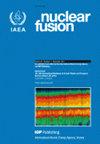温德斯坦 7-X 合成快速离子损耗探测器模型的验证
IF 4
1区 物理与天体物理
Q1 PHYSICS, FLUIDS & PLASMAS
引用次数: 0
摘要
我们首次提出了针对温德斯坦 7-X 恒星器(W7-X)中快速离子损耗探测器(FILD)的经过验证的合成诊断方法。该模型是在美国国家聚变科学研究所(NIFS-FILD)提供的快速离子损耗探测器(FILD)上开发的,并根据其实验数据进行了验证,未来可能适用于 W7-X 恒星器上现有的法拉第杯快速离子损耗探测器(FC-FILD)以及目前正在开发的闪烁快速离子损耗探测器(S-FILD)。结合蒙特卡洛代码 BEAMS3D 和 ASCOT5 的工作流程用于跟踪中性束注入产生的快离子,从电离到热化或从最后一个封闭的通量表面消失,并从那里跟踪到一个虚拟平面,该平面是 FILD 入口孔径的投影。ASCOT5 中的模拟通过几何方法进行分析,以确定作为归一化动量、俯仰角、陀螺相位和虚拟平面位置函数的穿过 FILD 孔径并传输到探测器上的概率。然后将这一概率应用于从等离子体到达的模拟离子,从而从计算量可控的模拟快速离子数量中产生模拟信号。本文介绍了两次中性束注入 W7-X 实验的模拟信号,并与 NIFS-FILD 诊断的实验测量结果进行了定量比较。对边缘中性粒子的电荷交换频率进行了估计,发现这一过程可能会对测量信号产生重大影响。本文章由计算机程序翻译,如有差异,请以英文原文为准。
Validation of a synthetic fast ion loss detector model for Wendelstein 7-X
We present the first validated synthetic diagnostic for fast ion loss detectors (FILDs) in the Wendelstein 7-X (W7-X) stellarator. This model has been developed on, and validated against experimental data from, a FILD provided by the National Institute for Fusion Science (NIFS-FILD), with potential future applicability to the existing Faraday Cup FILD (FC-FILD) on W7-X as well as the scintillating FILD (S-FILD) currently under development. A workflow combining Monte Carlo codes BEAMS3D and ASCOT5 is used to track fast ions produced by neutral beam injection from the moment of ionization until they are thermalized or lost from the last closed flux surface, and from there to a virtual plane which serves as a projection of the entrance aperture to the FILD. Simulations in ASCOT5 are analyzed via a geometric method to determine the probability of transmission through the FILD aperture and onto the detector as a function of normalized momentum, pitch angle, gyrophase, and position at the virtual plane. This probability is then applied to the simulated ions arriving from the plasma, producing a simulated signal from a computationally tractable number of simulated fast ions. Simulated signals are presented for two W7-X experiments with neutral beam injection and quantitatively compared with experimental measurements from the NIFS-FILD diagnostic. An estimate of the frequency of charge-exchange with neutral particles in the edge is performed, and it is found that this process may have a significant impact on the measured signals.
求助全文
通过发布文献求助,成功后即可免费获取论文全文。
去求助
来源期刊

Nuclear Fusion
物理-物理:核物理
CiteScore
6.30
自引率
39.40%
发文量
411
审稿时长
2.6 months
期刊介绍:
Nuclear Fusion publishes articles making significant advances to the field of controlled thermonuclear fusion. The journal scope includes:
-the production, heating and confinement of high temperature plasmas;
-the physical properties of such plasmas;
-the experimental or theoretical methods of exploring or explaining them;
-fusion reactor physics;
-reactor concepts; and
-fusion technologies.
The journal has a dedicated Associate Editor for inertial confinement fusion.
 求助内容:
求助内容: 应助结果提醒方式:
应助结果提醒方式:


